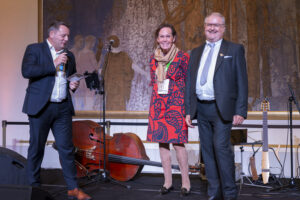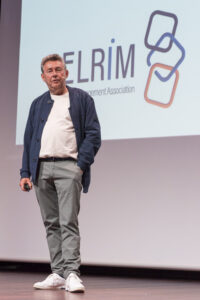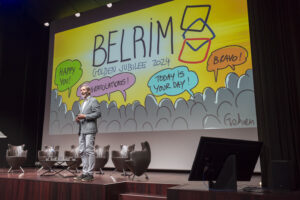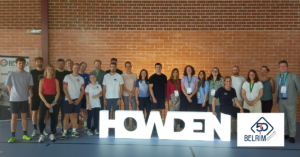New president
Gaëtan Lefèvre, Head of Professional Ethics Risk and Insurance Management at John Cockerill, opened the celebrations of the Golden Jubilee knowing it would be his last day as chairman of BELRIM and during his opening remarks his successor, Bart Smets was alongside him. “Of course, the world has changed dramatically in the last 50 years,” he said. “But the same goes for risk management. It’s an undeniable fact that risk managers have become more important in companies, and thanks to technology and their ability to think outside the box, they will be able to turn present risks into opportunities.” For him, the flexibility and the ability to see opportunities where someone else sees only risks are the hallmarks of risk managers.
In recent years, BELRIM has organized over 300 events for its members. These exchanges have always focused on current market topics. “They have proved to be excellent opportunities for learning and networking, the two foundations of BELRIM. Remember, we started out with a handful of risk and insurance managers from big industry. They were then joined, as a separate category, by brokers, insurers, surveyors, loss adjusters, lawyers, and so on. Thanks to them, we have obtained more financial resources that have enabled us to reach a higher level. All in all, BELRIM now represents some 350 risk and insurance professionals,” Lefèvre told the 200 or so attendees.
Bart Smets, head Risk & Insurance at Umicore, agreed that BELRIM has become more important over the years. “New risks pose major challenges, but through joint consultation, we find new means of guarding against future dangers. And BELRIM is more than ready to provide practical and constant assistance to its members. Thanks to our extensive network, we can always count on top speakers and specialists who are happy to come and share their knowledge with our members. Case studies are also frequently used, and we always emphasize the practical aspect so that our training courses provide real added value. As an association, BELRIM will continue to support its members by organizing both live and online seminars and spontaneous sharing of experiences. All this ensures that risk management in 2024 is ready for the future.” For Smets, learning to ride the waves of change is a greater guarantee of success than swimming against the current.
The outgoing chairman Lefévre concluded his opening remarks pointing out why BELRIM chose ‘Ceci n’est pas un risque. Het is een opportuniteit’ as the theme of the day. “It refers to the bipolarity of our profession and is inspired by René Magritte’s famous quote ‘Ceci n’est pas une pipe.’ We chose the Royal Museums of Fine Arts in Brussels and the Magritte Museum not by chance. The painter Magritte had a very particular vision of reality, and perhaps we can learn something from his surrealist point of view. What you see is not what you see. His paintings make you think. Sometimes you must rack your brains, step back, study the details, interpret the nuances, look at them from different angles. Isn’t that precisely the strategy of a good risk manager?”
At the end of the Golden Jubilee, Bart Smets officially received the torch as the new chairman from the outgoing president, Gaëtan Lefèvre, who was honoured, together with former Belrim-president Marie Gemma Dequae, each for their 11 years of service at the helm of the organisation. Lefèvre, however, will continue to contribute to BELRIM as a board member. He wished his successor well and noted that with Bart in charge, he knows BELRIM is in good hands.
Good to note that money was also raised for Proper Strand Lopers vzw and the Stichting tegen Kanker/Fondation contre le Cancer.
Bart Smets (l.), Marie Gemma Dequae en Gaëtan Lefèvre (r.)
Expect the unexpected
In the morning session of the Golden Jubilee the focus was clearly on the heightened security risks in the world. And that was immediately clear when Rudi Vranckx, war correspondent for VRT for more than 30 years, stepped onto the stage. He began with a quote from the Italian Antonio Gramsci: “Hope for the best and prepare for the worst.” His extensive travels through various war zones and conflicts had taught him this lesson. Initially hesitant to speak at the event, Vranckx eventually accepted with enthusiasm after realizing that war correspondents and risk managers share a similar perspective.
Vranckx shared tips from his experiences in conflict zones that could also benefit risk managers in their daily work. His first tip was to be prepared and flexible, and his second was to build a network by connecting with the right people. However, he emphasized that trusting the right people is crucial, a skill that comes with time and experience. His most striking statement was undoubtedly, “Expect the unexpected,” highlighting the need to remain vigilant and focused. Vranckx also warned for an unpredictable world with increasing uncertainties.
In the second part of his speech, Vranckx focused on technology, questioning whether it is a friend or an enemy. “I thought that tech would open the door to freedom in the world, especially when the Arab Spring erupted in 2011,” he said. “At the same time, Ayman al-Zawahiri, the number two of Al-Qaeda, stated that with the breakthrough of technology, their time had come. I remember thinking to myself: what does this old fool, hiding in the mountains, know about tech? But it turned out he was right, and instead, we got online propaganda, fake news, and cybercrime. For journalists, this is now our frontline, and it seems like dictators are on the rise thanks to disinformation.”
According to Vranckx, a new Cold War has arrived, and the narratives of the ’80s are returning. “We can’t put our heads in the sand anymore and will have to think in geostrategic terms.” At the same time, he is very concerned about climate change, which is already acting as an accelerant in conflicts. However, the risk of the breakdown of social cohesion worries him the most because it cannot be touched or controlled. He ended his talk with a quote from the Lebanese writer Amin Maalouf: “We entered a new era without a compass. My worries are those of a follower of enlightenment. One who sees the light flicker, grow weaker, and in some countries even go out. These are the worries of someone who cherishes freedom.” These are observations Vranckx encounters daily in his work as a war correspondent.
Serious business…
With retired Vice-Admiral of the Belgian Navy, Wim Robberecht, and his keynote “Risks, Threats & Opportunities through the Eyes of an Intelligence Service,” the Golden Jubilee continued to highlight the increased insecurity on a global scale. With his extensive naval career and experience heading the Intelligence and Security Service, Robberecht offered invaluable insights into the strategic landscape of modern intelligence operations. Notably, it is rare for a senior member of the intelligence community to speak in public. He began by saying that the big difference between Rudi Vranckx and him is that Vranckx informs the public, while he informs the government so that the government can take necessary actions.
“Today we live in a new world, and the New Cold War has already started,” he warned. “Our democratic model is under pressure while uncertainty is on the rise, causing people to be angry. On top of that, our society is polarized. Things are black and white, and the grey zone doesn’t exist anymore: you’re either with them or with us. We also see that other nations or groups focus on bringing down the Western democracy model with hybrid warfare, which is much easier than waging a real war.” He added that everything is now connected, and as the environment changes, crime is changing. “Cybercrime, in all its known forms, is evolving at an enormous speed.”
Robberecht warned that Belgium, being the complex country it is, should harmonize the attributions and responsibilities for national security interests across all levels. “Be it the EU level, the purely Belgian level, the federal level, our regions, our provinces, and even our cities. They all face the same problem: they cannot cope with the growing threat and the ever-better-connected and organized enemies by themselves. There should be a common denominator for security issues within our country so that we become a more resilient public service. We should also build bridges towards companies.” He concluded by saying that each company should also internally reflect on becoming more resilient.
Panel discussion
And after the introduction of Wim Robberecht there was a panel discussion with himself, the ever present Gaëtan Lefèvre, Yvan De Mesmaecker Secretary General European Corporate Security Association, Yves Brants, the President of the Scientific Committee of BELRIM and Christian Reimann, Head of Risk Engineer at HDI Group DE. The discussion was about cybersecurity threats in the digital age, focusing on risks from advanced technologies like artificial intelligence (AI).
Participants talked about deepfake technology, ransomware attacks, and vulnerabilities in supply chains that challenge organizations worldwide. They stressed the importance of raising awareness and preparedness to combat cyber threats effectively. They emphasized the need for a proactive and collaborative approach to cybersecurity because threats are always evolving and becoming more sophisticated.
Participants also discussed the importance of planning for the future with rapidly advancing technologies like AI and quantum computing. They highlighted the need to keep up with technological developments and anticipate cyber threats to reduce risks effectively.
The debate also covered the role of government cybersecurity centers in guiding and supporting businesses to improve their cybersecurity defenses. By promoting preparedness and sharing information, organizations can strengthen their resilience against cyberattacks and protect their digital assets.
Additionally, participants talked about how climate change intersects with cybersecurity, showing how environmental risks and digital vulnerabilities are connected. They emphasized the importance of a comprehensive risk management approach that considers various factors affecting organizational security.
In conclusion, the debate emphasized the importance of proactive risk management, continuous learning, and collaboration in navigating the ever-changing cybersecurity landscape. By having a forward-thinking mindset, using emerging technologies wisely, and staying alert to evolving threats, organizations can improve their cybersecurity and protect their operations in a digital world.
…followed by a funny twist
During the day there were two Visual Talks with Antoine Henry de Frahan, visual facilitator and former lawyer. While he listened to the presentations of all the speakers, he drew the things that struck him most. Listening and drawing are perfectly compatible, he explained, that’s just how our brain works. All his drawings from throughout the day can be found here. As you can see, he had a lot of material to use in his works.
Artificial Intelligence
Christiane Busche, Analytics Transformation at HDI Global SE and her colleague Brandon Schwab, Data Scientist at the group, put the focus point on AI and its potential for the insurance industry. “The value potential and ease of capture is really, really huge for us as an industry,” Busche said and she highlighted the transformative power that data and AI technologies hold in revolutionizing critical business operations and driving strategic decision-making processes. “By harnessing the capabilities of analytics and AI, organizations within the insurance and financial sector can unveil a realm of untapped opportunities and efficiencies that pave the way for sustainable growth and competitive advantage.”
And Schwab added that today we have different streams of AI such as narrow AI, machine learning, and generative AI. “I want to shed light on the diverse spectrum of AI technologies, each catering to distinct functionalities and use cases. While narrow AI specializes in performing specific tasks with precision, machine learning empowers algorithms to detect patterns and make informed predictions, and gen AI facilitates the creation of new content based on learned patterns, ushering in a new wave of innovation and creativity within the industry.” And Busche put these facts into numbers. “In jobs where you need a higher education, creative jobs, 25% of the tasks that are being done, can be improved by AI.” But it comes with a warning because we need to use AI responsibly and ensure human verification of the results we obtain. “This crucial directive underscores the imperative need for ethical AI practices, human oversight, and vigilance in mitigating biases and potential risks inherent in AI algorithms. By upholding principles of responsible AI usage and transparency, organizations can cultivate trust, mitigate risks, and foster a culture of ethical AI adoption that aligns with societal and regulatory standards.”
Brandon Schwab articulated, “We see AI as a good assistant for us, helping us improve our work and be more efficient. Embracing AI as a supportive tool rather than a disruptive force empowers organizations to embark on a transformative journey towards digital excellence, resilience, and sustainable growth in the ever-evolving business landscape.”
Young BELRIM’s meeting with Kim Gevaert
Meanwhile Young BELRIM, accommodating young members under 35, with the support of partner Howden Belgium had the pleasure of welcoming the Olympian Gold Medalist Kim Gevaert. She gave a workshop on sports and health, shedding light on challenges faced by professional athletes such as competing in higher temperatures due to climate change, negotiating sponsor contracts, and adapting to changing legislative environments. And some of these challenges are intertwined with the insurance industry.
Senior Client Manager at Howden Belgium, Simon Ginis shared three main takeaways with the participants:
–Enjoy your work and stay curious. Embrace technology like artificial intelligence but remember it’s a people’s business. Reach out via phone instead of relying solely on online contacts.
–Find a mentor in your industry for guidance.
–Acknowledge the role of luck in life and career. Give back to the community and support good causes to make a positive impact.
What could go wrong?
In the afternoon BELRIM in cooperation with several of its partners organized several workshops on the highly topical subjects of supply chain risk with Gold Sponsors of the Jubilee Aon. The workshops elaborated on how risk managers handle, diagnose and mitigate risk transfer for the different types of supply chain risk which they incur in their organizations. Grant Foster, Managing Director for Aon Global Risk Consulting UK, talked about his extensive experience in performing supply chain diagnostics since he was one of the first risk professionals in Europe to work on effective and practical tools to allow corporations to map their various supply chain risks. Another Gold sponsor
Allianz Commercial, took a journey through the key challenges of climate risk in a workshop named ‘Climate Crisis Chronicles – Navigating the Storm of Climate Risk’. It included possible pitfalls in climate strategy from carbon credits to climate litigation and the potential impact of climate change on both your business performance and physical assets. During the workshops the attendees explored the risks associated with extreme heat on the workforce or the communities organizations operate in.
Very interesting was the workshop on art and risk management organized by BELRIM with Platinum Sponsor HDI Global SE. Three experts talked about what could wrong with art and since the Golden Jubilee took place at the Royal Museums of Fine Arts the subject couldn’t have been better.
-Maarten Lousbergh kicked off the session. He is the Head of Facility and Internal Security at the Royal Museum of Fine Arts. When he asked what kind of problems he could face, participants immediately thought of theft, water damage, fire, and vandalism due to recent actions by climate protesters. However, there is much more that can go wrong, such as human error, equipment failure, animals entering the museum unnoticed (such as pigeons), bacteria (also from human visitors), heating issues, and more. Sometimes, the artwork itself poses a danger, like Wim Delvoye’s Cloaca. For Lousbergh, prevention is paramount, and his team plays an active role daily to ensure this.
–Estelle De Bruyn spoke next. She is the Head of the Sustainability Unit at the Royal Institute of Cultural Heritage (KIK-IRPA, Brussels). She guides the heritage sector towards eco-responsibility by implementing practical tools, national strategies, and interdisciplinary research projects. Her focus is particularly on crisis management, reducing energy consumption, and societal utility. She immediately highlighted the 2021 flood in Wallonia and its impact on the region’s art heritage. Much was lost for various reasons, but the most striking issue was the poor distribution of responsibility. It also became apparent that many buildings and works of art were underprepared and inadequately protected against a natural disaster. Subsequently, assessing all the damage and coming up with quick, adequate solutions proved challenging.
–Alexander Wiebe, the head of the German Fine Art & Specie Team at HDI Global Specialty, discussed art insurance and its workings. All art is insurable, but he is reluctant to insure vintage cars, he joked. “You’ll understand when you see the price of a new windscreen.” He emphasized that it is a growing market, not exclusive to high-net-worth individuals: a democratization of the market is in full swing. However, just as Maarten Lousbergh and Estelle De Bruyn noted, he stressed that many things can go wrong, and a robust insurance market for this segment is essential.
You can find the gallery with a selection of pictures of the event here.











